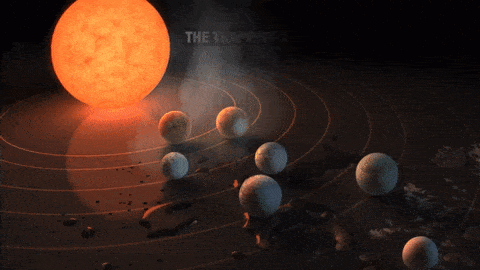
Stellar Evolution
Quiz
•
Science
•
9th - 12th Grade
•
Practice Problem
•
Hard
Standards-aligned

Clint Sandford
Used 697+ times
FREE Resource
Enhance your content in a minute
20 questions
Show all answers
1.
MULTIPLE CHOICE QUESTION
45 sec • 1 pt

High-mass stars burn hotter & brighter because they have more _______ at their cores.
fusion
fuel
energy
pressure
Tags
NGSS.HS-ESS1-1
NGSS.HS-PS1-8
2.
MULTIPLE CHOICE QUESTION
1 min • 1 pt

Why do high-mass stars skip the helium flash stage that low-mass stars go through before dying?
Not enough hydrogen at the core.
Once hydrogen is used up at the core the star explodes.
Once helium is used up at the core the star explodes.
High-mass stars never die.
Tags
NGSS.HS-ESS1-3
3.
MULTIPLE CHOICE QUESTION
45 sec • 1 pt

When temperatures are high enough in the core of a high-mass star, this element starts to form.
helium
carbon
oxygen
hydrogen
Tags
NGSS.HS-ESS1-3
4.
MULTIPLE CHOICE QUESTION
45 sec • 1 pt

When fusion in low-mass stars form this element in its core, the helium flash stage begins.
helium
carbon
oxygen
hydrogen
Tags
NGSS.HS-ESS1-1
NGSS.HS-ESS1-3
NGSS.HS-PS1-8
5.
MULTIPLE CHOICE QUESTION
45 sec • 1 pt

When an ______ core is reached in a high-mass star, gravity takes over.
iron
carbon
oxygen
helium
Tags
NGSS.HS-ESS1-3
6.
MULTIPLE CHOICE QUESTION
45 sec • 1 pt

When an iron core is reached gravity takes over and a(n) _________ occurs.
black hole
neutron star
explosion
supernova
Tags
NGSS.HS-ESS1-3
7.
MULTIPLE CHOICE QUESTION
45 sec • 1 pt

Supernovas are one of the largest _______ in the Universe.
events
stars
explosions
objects
Tags
NGSS.HS-ESS1-3
Create a free account and access millions of resources
Create resources
Host any resource
Get auto-graded reports

Continue with Google

Continue with Email

Continue with Classlink

Continue with Clever
or continue with

Microsoft
%20(1).png)
Apple
Others
Already have an account?
Similar Resources on Wayground

15 questions
Compounds of Life Topic Quiz
Quiz
•
9th - 10th Grade

15 questions
PE Q2 - QUIZ UNDERSTANDING LIFESTYLE AND WEIGHT MANAGEMENT
Quiz
•
10th Grade

19 questions
Light as a Wave & Particle Quiz
Quiz
•
11th Grade

15 questions
Cell Transport Vocabulary Quiz
Quiz
•
9th Grade

18 questions
The Cell
Quiz
•
10th Grade

20 questions
Unit B Section 3 Review
Quiz
•
9th Grade

15 questions
ROCKS AND MINERALS
Quiz
•
11th Grade

17 questions
26.2 Properties of Alpha, Beta, and Gamma radiation
Quiz
•
12th Grade
Popular Resources on Wayground

5 questions
This is not a...winter edition (Drawing game)
Quiz
•
1st - 5th Grade

15 questions
4:3 Model Multiplication of Decimals by Whole Numbers
Quiz
•
5th Grade

25 questions
Multiplication Facts
Quiz
•
5th Grade

10 questions
The Best Christmas Pageant Ever Chapters 1 & 2
Quiz
•
4th Grade

12 questions
Unit 4 Review Day
Quiz
•
3rd Grade

10 questions
Identify Iconic Christmas Movie Scenes
Interactive video
•
6th - 10th Grade

20 questions
Christmas Trivia
Quiz
•
6th - 8th Grade

18 questions
Kids Christmas Trivia
Quiz
•
KG - 5th Grade
Discover more resources for Science

10 questions
Exploring the Energy Cycle: Photosynthesis and Cellular Respiration
Interactive video
•
6th - 10th Grade

15 questions
Domain 3 – Classification: 15-Question Assessment
Quiz
•
9th Grade

10 questions
Exploring Plate Tectonics and Their Boundaries
Interactive video
•
6th - 10th Grade

15 questions
Domain 4 – Evolution: 15-Question Assessment
Quiz
•
9th Grade

15 questions
Domain 5 – Ecology: 15-Question Assessment
Quiz
•
9th Grade

10 questions
Exploring Light and Waves Concepts
Interactive video
•
6th - 10th Grade

10 questions
EOC Domain 3: Taxonomy
Lesson
•
9th - 10th Grade

9 questions
EOC Domain 4: Evolution
Lesson
•
9th - 10th Grade



